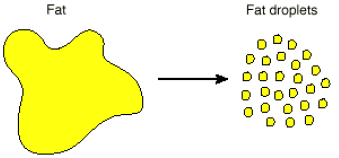DIGESTIVE SYSTEM
4 Types of Tissues
1. Epithelial (cover exposed surfaces, line inner passages, forms glands, skin)
2. Connective (fill internal spaces, support other tissue, transport material, store energy, tendons, ligaments)
3. Muscle (contraction, skeletal muscle, provide heat, wall of organ tissues)
4. Neural (carries electrical impulses from brain to rest of the body)
Muscular System
Voluntary - Consciously
Involuntary - Naturally; subconsciously
5 Phases of Digestion
1. Ingestion
2. Movement
3. Mechanical & Chemical Digestion
4. Absorption
5. Elimination
Mechanical Digestion
- Physical
- Chew (mastication), tear, grind, mix etc.
Chemical Digestion
- Chemically using enzymes to break down food into simpler substances, e.g. carbs, fats, protein, minerals, vitamin, fibre
Gastro Intestinal Tract (GI Tract)
- 1 long tube from mouth to rectum
- Connecting following organs with it:
-
Mouth
-
Esophagus
-
Liver
-
Gall Bladder
-
Stomach
-
Pancreas
-
Small and Large Intestine
-
Rectum
Mouth
- Mechanical
-
Teeth breaking down food
-
Tongue mixing food with saliva
- Chemical
-
Saliva contains amylase (digests starch - carbohydrates)
- Food becomes 'bolus' which goes through the epiglottis and through the esophagus
- Bucal Cavity: Mouth area
Esophagus
- Approximately 10" long (leaves space for respiratory system)
- Allows food time to digest
- Secretes mucus (to lubricate bolus)
- Mucus traps bacteria
- Peristalisis moves bolus from the mouth to the stomach (antagonistc muscle pair [work in opposites] present in esophagus)
Stomach
- Mechanical
-
Muscles churn chyme in stomach constantly
- Chemical
-
Enzymes
-
Hydrochloric Acid (HCl) 1.5 pH
- HCl (digestive juice inside stomach) kills all trapped bacteria in mucus
- Protease (digests protein) and lypase (digests lipids/fats) present in stomach
- Food/HCl mix is called chyme
- Not enough mucus lining the stomach causes heartburn (stomach starts digesting itself)
- Approximately 4 hours in the stomach
Small Intestine
- Approximately 7 meters long
- Absorbs digested food material
- Pancreatic amylase (for all nutrients)
- Has villi and micro villi -> increases S.A. : V & allows materials to be absorbed quicker
Large Intestine
- Approximately 5 feet
- Accepts waste from small intestine, stays for 4 hours
- Allows:
-
Bacterial Digestion
-
Water Absorption (Also in small intestine)
-
Concentrates waste
- Waste leaves via rectum
Appendix
- Huge in herbivores (diet consists mainly of fibre)
- Contains bacteria (natural flora) to digest cellulose in fibre
Pharynx - Throat
Larynx - Voice Box
Bucal Cavity - Mouth

Figure 1. Entire GI Tract connected with various organs

Figure 2. Mouth

Figure 3. Esophagus

Figure 4. Stomach

Figure 5. Intestines

Figure 6. Villi
Accessory Organs
Liver
-
Largest organ in body
-
Produces bile
-
A digestive fluid, stored in the gall bladder. Created by the breakdown of RBCs. Helps emulsify fats (breaks down fat globules into smaller globules so that enzymes can work faster [have greater S.A.])
-
-
Filters and breaks down toxins
Gall Bladder
-
Stores bile and releases it in small intestine
-
Fatty diet causes gallstones
Pancreas
-
Production of digestive enzymes
-
Lypase (lipids)
-
Amylase (carbohydrates)
-
Protease (proteins)
-
Pancreatic Amylase (all)
-
-
Regulates blood sugar by making insulin
-
If brain does not get sugar, there will be cellular damage
-


Figure 7. To sum it all up
Figure 8. Emulsification of fat